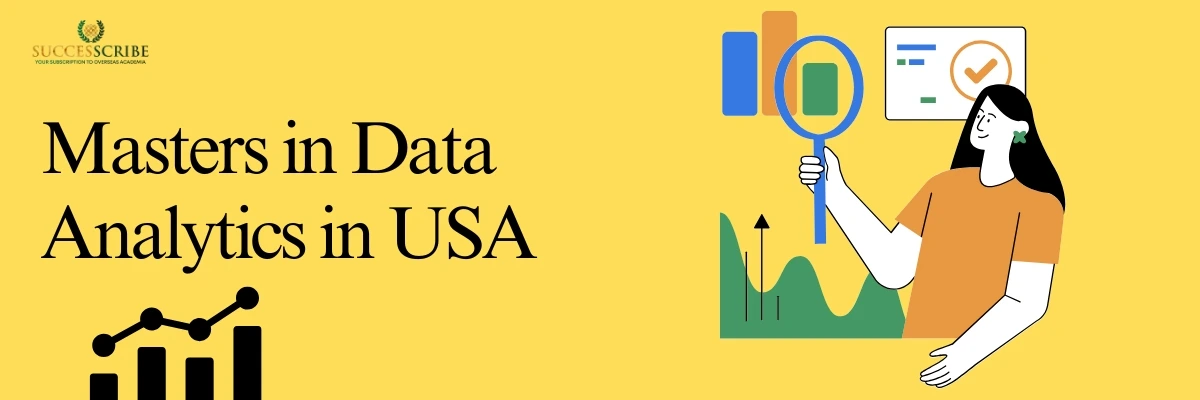Data is the new oil. And just like crude oil needs refining, data requires analytics. In today’s world, organizations are flooded with data but it’s the professionals who can interpret and utilize this information who are truly in demand.
If you’re someone interested in making sense of numbers, discovering patterns, and using data to drive decisions, a Master’s in Data Analytics in the USA could open up doors to some of the most exciting and high-paying roles in the industry. The U.S. offers access to world-class universities, a vibrant job market, and practical, industry-oriented learning. Choosing to pursue your Masters in data analytics in USA gives you a globally recognized degree with real-world value.
Let’s dive deep into what makes the USA a hotspot for data analytics education and how you can start your journey.
Overview of MS in Data Analytics in the USA
The field of data analytics is expanding rapidly, with the global big data market projected to hit $103 billion by 2027 . A Masters in Data Analytics in USA provides students with expertise in data mining, machine learning, statistical modeling, and business intelligence.
15 Reason Why USA is best for Masters in Data Analytics

The U.S. remains the top choice for this degree due to its prestigious universities, strong industry ties, and lucrative job prospects. According to the U.S. Bureau of Labor Statistics (BLS), data science roles are expected to grow by 36% from 2021 to 2031, significantly faster than most other professions.
- The U.S. Bureau of Labor Statistics (BLS) projects a 35% job growth for data-related roles between 2022 and 2032.
- Over 170,000 new jobs are expected to be created in the U.S. data industry by 2032.
- Average salaries for graduates of data analytics programs are high, with:
- Data Analyst earning around $74,000/year
- Data Scientist earning around $122,000/year
- Machine Learning Engineer earning about $130,000/year
- Big Data Engineer earning up to $135,000/year
- Business Intelligence Analyst earning around $85,000/year
- Return on investment (ROI) for graduates is strong, with most recovering tuition costs within 1–2 years post-graduation.
- Programs in the U.S. offer hands-on training in leading tools like Python, R, SQL, Hadoop, Spark, Tableau, and Power BI.
- Students work on real-world industry projects and capstone assignments integrated with classroom learning.
- Many universities have partnerships with companies like Google, Microsoft, Amazon, Meta, and IBM.
- Strong job placement support and recruitment through on-campus career fairs and industry events.
- International students benefit from the STEM OPT extension, allowing them to work in the U.S. for up to 3 years after graduation.
- STEM designation increases the chances of securing long-term roles and H-1B sponsorship.
- Data analytics roles are in demand not only in tech but also in healthcare, finance, marketing, e-commerce, supply chain, and sports.
- 82% of Fortune 500 companies now use advanced data analytics in their operations (McKinsey report).
- Curricula are frequently updated to match industry trends, including electives in AI, machine learning, financial analytics, and more.
- U.S. universities emphasize practical, project-based learning alongside academic coursework.
- Students can customize their learning paths through electives and specializations based on industry demand.
Suggested: Best studienkolleg in Germany
Top Collage/Universities for Master’s in Data Analytics in USA

If you’re wondering, “Are there specific universities for Masters in Data Analytics in USA?” The answer is yes, and it’s important to know the distinction. Some universities offer dedicated, full-time Master’s programs in Data Analytics, while others provide a Data Analytics specialization or track within broader programs like Computer Science, Information Systems, or Business Analytics.
Here’s a breakdown to help you understand which universities offer what:
Top Collage/Universities with a Dedicated Master’s in Data Analytics Program
Here’s a refined list of specific universities offering MS in Data Analytics or highly focused equivalents:
| University | Program Name | Tuition (Approx.) | Delivery |
| Northeastern University | MS in Data Analytics | $36,000 | On-campus |
| Johns Hopkins University | MS in Data Analytics and Policy | $58,000 | On-campus/Online |
| University of Chicago | MS in Analytics | $66,924 | On-campus |
| University of California, Berkeley (UCB) | Master of Analytics | $35,218 | On-campus |
| George Washington University | MS in Data Analytics | $31,950 | On-campus |
| Tufts University | MS in Data Analytics | $28,849 | On-campus |
| Georgia State University | MS in Data Science and Analytics | $29,000 | On-campus |
| Louisiana State University (LSU) | MS in Analytics | $28,000 | Online |
| Carnegie Mellon University (CMU) | MS in Computational Data Science | $58,000 | On-campus |
| Boston University | MS in Applied Data Analytics | $63,798 | On-campus |
| Oregon State University | MS in Data Analytics | $32,000 | Online/On-campus |
| University of Maryland | MS is Data Science and Analytics | $36,000 | On-campus |
| Texas A&M University | MS in Analytics | $35,000 | Online/On-campus |
Suggested Post: Top universities for masters in Germany
Top Universities Offering Data Analytics as a Specialization/Track
These universities embed Data Analytics within a broader field such as Computer Science, Business Analytics, or Information Systems:
| University | Primary Program | Specialization in Data Analytics |
| Columbia University | MS in Applied Analytics / Data Science | Business and Data Analytics focus |
| Stanford University | MS in Statistics / Management Science & Engineering | Data Science and Machine Learning Track |
| Massachusetts Institute of Technology | MS in Business Analytics / Electrical Engineering & CS | Data Analytics through Business Analytics |
| University of Michigan, Ann Arbor | MS in Information / Data Science | Data Analytics or Information Analysis Specializations |
| Cornell University | Master of Professional Studies in Applied Statistics | Data Science and Analytics Track |
| University of Southern California (USC) | MS in Applied Data Science / Business Analytics | Data Analytics Electives and Industry Projects |
| Indiana University Bloomington | MS in Information Systems | Analytics and Business Intelligence Concentration |
| University of Florida | MS in Information Systems and Operations Management | Data Analytics Specialization |
| University of Minnesota – Twin Cities | MS in Business Analytics / Computer Science | Data Analytics and Data Mining Electives |
| University of Illinois Urbana-Champaign | MS in Information Management / Data Science | Analytics and Data Science Concentration |
| University of Pittsburgh | MS in Information Science | Data Analytics and Visualization Track |
Suggested: Top low cost universities in Germany
Do I Need to Give GRE for Master’s in Data Analytics in USA?
The GRE (Graduate Record Examination) has traditionally been a key requirement for graduate admissions in the United States. However, in recent years, especially post-pandemic, many universities have revised their admissions policies to make the application process more inclusive and accessible.
Current Trend: GRE-Optional or Waived
Many top universities offering a Masters in data analytics in USA have made the GRE optional or waived it entirely. This means students can apply without submitting GRE scores, and it won’t disadvantage them during the admissions review. Some programs evaluate applicants based on their GPA, statement of purpose, work experience, and letters of recommendation instead.
Examples of Universities Not Requiring GRE
| University | GRE Requirement |
| Columbia University | Not Required |
| Northeastern University | Optional |
| University of California, Berkeley | Waived for 2025 |
| New York University (NYU) | Optional |
| Georgia Institute of Technology | Recommended, not mandatory |
When GRE is Still Helpful
- If you have a lower GPA or come from a non-technical background, a good GRE score (310+) might strengthen your application.
- Some scholarships and assistantship programs might still consider GRE scores.
Suggested: Blocked account in Germany
Program Structure and Curriculum for Masters in Data Analytics in USA

Most data analytics Master’s programs require 30-36 credit hours, typically comprising 10-12 courses. Programs generally span 12-24 months, though accelerated and part-time options exist. While the exact curriculum may vary slightly by university, here are some common modules you’ll study:
The curriculum typically includes:
Foundation Courses (18-24 credits)
These establish core competencies in:
- Statistical methods and probability theory
- Machine learning fundamentals
- Data mining techniques
- Programming for analytics (Python, R)
- Database systems and SQL
- Data visualization methods
- Big data technologies
- Ethics in data science and analytics
Specialized Electives (6-12 credits)
Students typically select courses aligning with their career interests:
- Business analytics tracks emphasize applications in marketing, finance, or operations
- Computational tracks focus on advanced machine learning, natural language processing, or computer vision
- Statistical tracks delve into experimental design, time series analysis, or Bayesian methods
- Domain-specific tracks apply analytics to healthcare, social media, or other industries
- Some of the electives are:
- Big Data Technologies
- Natural Language Processing
- AI for Business Decisions
- Time-Series Forecasting
- Blockchain for Data Analytics
- Cloud Computing
Many universities now offer capstone projects, internships, or thesis options as part of the program. This hands-on experience is especially beneficial for students pursuing a masters in data analytics in USA, as it helps them apply their classroom learning to real-world problems.
The syllabus is crafted to ensure students graduate with a solid foundation in both technical and business skills, which sets them apart in a competitive job market. Students can often customize their course paths to align with their career goals, such as focusing on finance, healthcare, or tech industries.
Suggested Post: Highest paying jobs in Germany
Admission Requirements for MS in Data Analytics in USA
Here is a breakdown of the essential eligibility criteria:
Academic Qualification
- A 4-year Bachelor’s degree from a recognized institution.
- Ideally in a related field like Computer Science, Mathematics, Engineering, Statistics, or Economics.
- A minimum GPA of 3.0 on a 4.0 scale is often expected.
GRE Scores (Optional at Many Universities)
Although some universities still require the GRE, many have now waived it to make the application process more accessible.
English Language Tests
| Test | Minimum Score |
| IELTS | 6.5 – 7.0 |
| TOEFL iBT | 90 – 100 |
| Duolingo | 110 – 120 |
Supporting Documents
- Statement of Purpose (SOP)
- Letters of Recommendation (2-3)
- Resume/CV
- Transcripts
- Portfolio (optional, but helpful)
The MS in Data Analytics admission requirements in USA may slightly vary by university, but strong academic and analytical capabilities are universally valued.
Universities also seek students who can demonstrate not only academic performance but also a clear motivation for choosing this program. Your statement of purpose should reflect your long-term goals and how a master’s in data analytics in USA will help you achieve them.
Suggested Post: Requirements to study in Germany
Cost of Studying MS in Data Analytics in USA

Understanding the financial investment required is crucial before applying. Here’s a breakdown of the total cost of studying in the U.S. for an international student pursuing a masters in data analytics in USA.
Tuition Fees
| University Type | Annual Tuition (USD) |
| Public Universities (in-state) | $12,000-$35,000 annually |
| Public Universities (Out-of-state) | $25,000-$52,000 annually |
| Private Universities | $40,000-$80,000 annually |
Living Cost
| Expense | Average Annual Cost (USD) |
| Accommodation | $10,000 – $15,000 |
| Food & Groceries | $3,000 – $6,000 |
| Transportation | $1,000 – $2,000 |
| Health Insurance | $1,200 – $2,500 |
| Books & Supplies | $800 – $1,200 |
Total Estimated Annual Cost: $40,000 – $95,000
While this seems high, students pursuing a masters in data analytics in USA often recover their investment within 1–2 years of employment post-graduation due to high salary packages and opportunities in the field.
Would you like me to continue with the sections on skills you learn, what to prepare before starting the program, scholarships, and top job opportunities?
Suggested Post: Cost of living in Germany for Indian students
Career Opportunities and Compensation

Analytics graduates enter a robust job market with diverse opportunities and competitive compensation:
| Position | Median Salary | Typical Range | Growth Forecast |
| Data Analyst | $130,000 | $100,000-$170,000 | 33% |
| Data Scientist | $135,800 | $105,000-$175,000 | 36% |
| Data Engineer | $132,400 | $100,000-$165,000 | 33% |
| Machine Learning Engineer | $145,700 | $115,000-$190,000 | 40% |
| Business Intelligence Analyst | $98,500 | $80,000-$125,000 | 23% |
| Analytics Manager | $142,600 | $115,000-$185,000 | 28% |
| Data Architect | $151,200 | $120,000-$190,000 | 27% |
| Marketing Analytics Specialist | $107,500 | $85,000-$140,000 | 22% |
| Healthcare Data Analyst | $96,800 | $75,000-$125,000 | 30% |
Skills You Will Learn in Masters in Data Analytics Program in USA

By the end of your MS in Data Analytics, you’ll be proficient in:
- Programming: Python, R, SQL
- Data Handling: Pandas, NumPy, Spark
- Visualization: Tableau, Power BI, Matplotlib
- Machine Learning: Scikit-learn, TensorFlow
- Big Data Tools: Hadoop, Spark
- Communication: Turning data into actionable business insights
What Should You Learn Before the Course?
Here’s a quick prep checklist before starting your degree:
- Introductory Python/R programming
- Basic Statistics (Mean, Median, SD, Hypothesis Testing)
- Linear Algebra & Calculus
- SQL and Database Basics
- Excel and Google Sheets
Suggested Post: Scholarships for Indian students in Germany
Preparation for Success in Analytics Programs
Students maximize their chances of success by developing foundational skills before beginning their programs:
Mathematics and Statistics Foundations:
- Calculus concepts (particularly differentiation and integration)
- Linear algebra fundamentals (especially matrix operations)
- Probability theory and distributions
- Basic statistical methods and hypothesis testing
Programming Fundamentals:
- Python basics (data structures, functions, and key libraries)
- R fundamentals for statistical analysis
- SQL for database querying
- Version control with Git
Data Experience:
- Exposure to data cleaning and preparation techniques
- Familiarity with basic visualization approaches
- Understanding of common data structures
Recommended Resources:
- Structured online courses through platforms like Coursera or edX
- Foundational texts like “Introduction to Statistical Learning”
- Practical platforms like Kaggle for hands-on experience
Educational research indicates students with prior programming and statistics experience are 3.2 times more likely to excel in graduate analytics coursework.
Conclusion
The field of data analytics continues to evolve rapidly, and the U.S. remains at the forefront of this transformation. With access to the best academic infrastructure, cutting-edge technologies, and an innovative work culture, studying an Masters in Data Analytics in USA is more than just an educational pursuit it’s an investment in your future.
From preparing for admission to mapping out career growth, this guide provides all the necessary details to kick-start your journey toward becoming a data-driven professional in one of the world’s most advanced economies.
FAQs
Is the USA good for a Master’s in Data Analytics?
Yes, the USA is one of the best countries to pursue a Master’s in Data Analytics. With top-ranked universities, world-class research facilities, and abundant job opportunities in tech and business sectors, the USA offers global exposure and career growth.
What is the average salary after MS in Data Analytics in the USA?
Graduates can expect an average salary of $85,000 to $120,000 per year, depending on the role and location. Senior positions like Data Scientist or Analytics Manager can earn $130,000 or more annually.
Is GRE required for MS in Data Analytics in the USA?
Many universities have made GRE optional or waived it entirely. However, top universities may still consider GRE scores to evaluate quantitative aptitude.
What are the top universities offering MS in Data Analytics in the USA?
Some of the best universities include MIT, Stanford, UC Berkeley, University of Chicago, Columbia University, and Johns Hopkins University. Others offer analytics as a specialization under data science, information systems, or statistics.
Which skills are required before applying for MS in Data Analytics?
Prior knowledge of:
1. Programming (Python/R)
2. Statistics and Linear Algebra
3. SQL and Excel
4. Basic machine learning concepts
It is highly beneficial for success in coursework and job placement.
Which are the top job roles after MS in Data Analytics in the USA?
Graduates often work as:
1. Data Analyst
2. Business Analyst
3. Data Scientist
4. Machine Learning Engineer
5. Quantitative Analyst
6. Product Analyst
Related Post
Masters in cloud computing in USA
Masters in computer science in USA
Masters in cyber security in USA
Cyber security courses in USA















